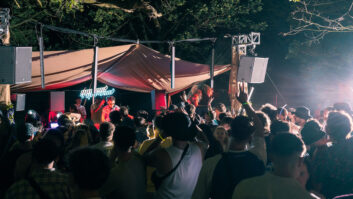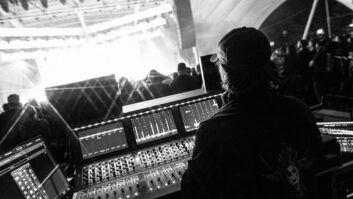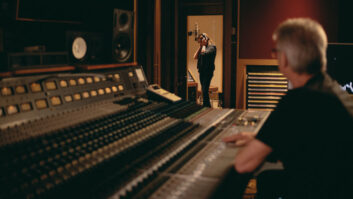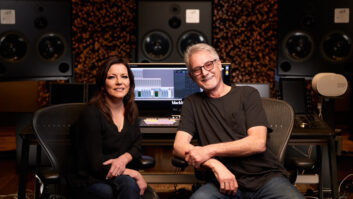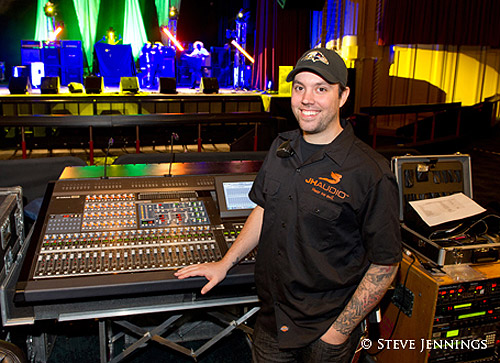
Hard-rockers Mastodon brought their high-energy set to San Franciso’s Warfield Theater in early November, part of a slew of fall tour dates to promote their latest, The Hunter. Mix caught up with the crew, who are relying on house-provided gear.
Front-of-house engineer Rob Lightner
Photos: Steve Jennings
At the San Francisco gig, Rob Lightner manned the venue’s Yamaha PM5D-RH, using the X-Hall and X-Plate for drums and vocals, along with the Voice Doubler and Reverb Flanger for certain songs. “This is the first time I have used the SC48 console at FOH, and it has been the best provided so far,” Lightner says, who normally specs for an Avid board. “I’m not carrying outboard gear; we are in the process of obtaining a few [units] from TC Electronic. They take great care of the band and I really like the M-One and the old faithful D-2. I use the SPX-990 when they are available to give me a couple vocal effects that they used on some albums.”
For P.A., Lightner is spec’ing a K-1 or d&b system, adding that “depending on the room, there are some places that have eight boxes a side, and that can either be perfect or just barely enough. Then there are the smaller venues that give me two Guitar Center JBL stacks per side—those days are always fun!” Tuning the system, he’ll play Bebel Gilberto’s “Cada Beijo” as the tune’s midrange gives him an idea of where the guitars will sit.
“This band has come a long way during their career, and it really shows in their performance,” Lightner says. “They are very tight together and have a really great groove. The guitar tones are dialed in, and a couple of the basses are some of the best I’ve heard with a metal band. I have known a few of the crew guys for some time and really looked forward to working with them. They all have a good grasp on what needs to happen each day.”
Bassist Troy Sanders plays through an Orange AD200, Mega Big Block 750 and Titan V12, and an Ampeg SVT-VR amps. According to bass tech/stage manager Darren Sanders, the bass pedal gear comprises a Wren and Cuff Russian Fuzz, TC Electronic Corona, Dunlop Bass Wah and a Radial JDI. He sings through a KSM9.
Stage-left guitarist Bill Kelliher has a double head case with a 12-space rack housing Shure UR40 wireless and an Audiotech Guitar Products 1×6 selector. The Marshall JCM 800s, Mega Boogie Royal and Diezel Herbert amps are miked with Audio-Technica 4033, Shure SM57 and Palmer PDI-9-, respectively. “Bill’s pedal board has a TC Electronic G-system running two loops with a hard-wired valve distortion Maxon analog delay,” says guitar tech Warren Termini. “A DigiTech Jam Man Sampler with FS3X foot controller runs into a Radial DI. Pedals are powered by a Dunlop DC Brick, which runs back to a drawer to a hum eliminator. One side goes to a Dunlop Smart gate, then to a Lee Jackson 1-in/4-out splitter. Two sends from the splitter go to two Marshall 100W JCM 800s. One head runs the Orange cabinet and the other runs the Mills cabinet.†The other side of the hum eliminator goes to a Dunlop Smart gate, then to a 50W Marshall JCM 800 and runs the 100W Marshall cabinet loaded with 20W Celestion Greenbacks.” Kelliher sings through a Shure Beta 57.
According to stage-right guitarist Brent Hinds’ tech, John Aray, Hinds’ pedal board comprises a Dunlop Cry Baby, Ernie Ball volume pedal, Boss GE-7 EQ, Morpheus Drop Tune, Orange Overdrive/Fuzz, Ibanez Tube Screamer (TS9), Boss NS-2 noise suppressor, Boss DD-6 digital delay, Boss RE-20 Space Echo and a Line 6 digital delay. His 1979 Marshall 100W JMP Mark II, Diezel VH4 and Modern Vintage Marshall amps are miked with a Shure SM57, an Audio-Technica 4033 and a Palmer PDI-9, respectively. Hinds sings through a Sennheiser e 945.

Monitor engineer Thomas “Chip” Valentino
When monitor engineer Thomas “Chip” Valentino is faced with an Avid console, he’ll employ Smack! for vocals. Inside the truck are a few dbx comps and gates that can be pulled out if needed, but Valentino says that the venue will normally have what he needs or will use onboard effects. He uses two gates on the bass drum channels, a comp on snare drum and bass channels, and lightly compresses the vocals.
“The band is entirely on wedges, the make and models of which are up to what the venue provides,” Valentino says. “In some cases, we may have to request that they bring in additional monitors if necessary. For instance, Brann [Dailor, drummer] needs two separate mixes behind the drums to reproduce what is going on with the guitars in front of the stage. I am also generating two stereo IEM mixes for Darren and Warren, who are Troy’s bass tech and Bill’s guitar tech. This way, they know immediately if something goes wrong.”
Drummer Brann Dailor’s kit is miked with Shure Beta 91 and Beta 52 on bass drum, Beta 57 on snare top, SM57 on snare bottom, Beta 98s on rack toms (“They are superb because they have such a low profile,” says drum tech Tom “Ozzy” Richens.), Audio-Technica ATM25 on floor tom, and KSM 109s on hat and ride. Overheads are venue-provided. Dailor sings through a Shure Beta 56.

